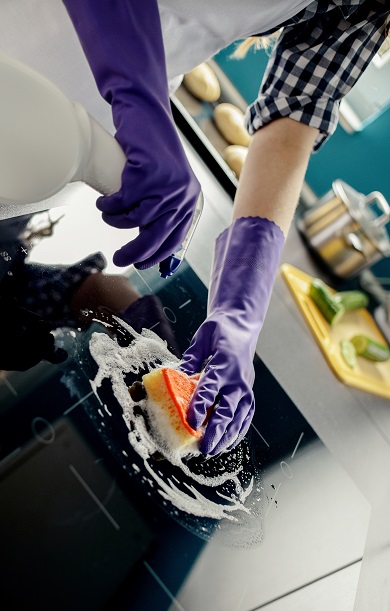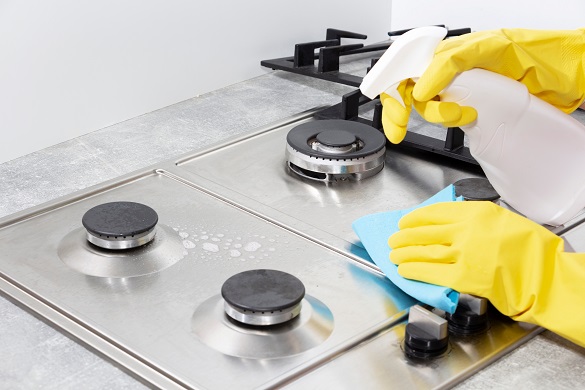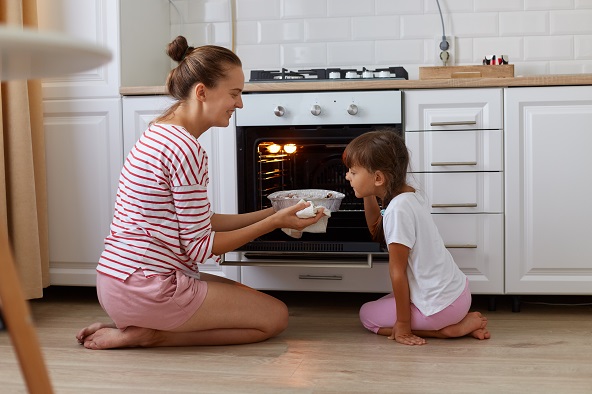It’s safe to say that cleaning the hob is not something many people look forward to. But it will keep your kitchen looking nice and could keep your hob working for longer. Like any cleaning, it’s easier the more often you do it – rather than letting grime build up and bake on.
So how often does a hob need cleaning? The answer depends on how much you use it. In general, it’s a good idea to wipe after each use and clean properly after every three uses.
Before doing any cleaning, we recommend checking for any specific instructions in the hob’s manual or manufacturer’s guide.
What you’ll need for the job

Safety first: make sure your hobs are cold and that the gas valve or electrical plug is switched off.
The materials you’ll need depend on the type of hob you have and how dirty it is. In each case you should wear cleaning gloves and eye protection when using chemicals.
For a gas hob, you’ll need these items:
- A bucket or sink of warm water with washing up liquid
- Cleaning spray
- Two soft cloths – one for cleaning, one for buffing
- A toothbrush
- A soft-bristled scrubbing brush
For an induction or ceramic hob, you’ll need:
- A non-scratch sponge
- General cleaning spray
- Hob cream cleaner or baking soda
- Two soft cloths
- Glass cleaning spray
- For a ceramic hob, you may need a hob scraper as well (for burnt-on marks)
And for an electric hob, you’ll need:
- Cleaning spray
- One cloth large enough to lay across the whole hob
- Another cloth for wiping
- A toothbrush
Which cleaner to use on your hob?
Check your hob’s manual for any cleaning ingredients that shouldn’t be used. While there are products sold specifically for hob cleaning, a standard kitchen degreaser should also work.
For a cheap and less toxic cleaner, you can use baking soda. Just mix water and baking soda into a spreadable paste and leave it on the hob for 30 minutes before wiping. Also see our detailed advice on how to make natural cleaning products yourself.
How to clean gas hobs

Gas safety: first, be sure to turn off the gas valve leading to your hob.
To start, take all the removable parts off the top of the hob. These are usually some rectangular metal racks and the metal discs in the burners. You might also see them referred to as pan supports and burner caps and heads. They aren’t held in place, so you can just lift them off.
Avoid scratches: don’t drag the metal pieces off the hob, as this could damage the surface. Pick them straight up before taking them away.
Fill your sink or a bucket with warm water and washing up liquid. Put the removable parts in there to soak while you’re cleaning. Don’t leave them for hours and hours though, as they could rust.
Now on to cleaning the hob surface.
- Use a damp cloth to wipe off any dirt – especially around the gas rings, where food tends to build up
- Spray your cleaning fluid on the hob, leave it for a few minutes and wipe with a damp cloth
- Clean the cloth and repeat the step above until all the grime is gone
- Drain the water from the sink or bucket where you put the removable parts earlier
- Clean the removable parts with a cloth, sponge or old toothbrush
- Rinse and dry the removable parts
- Shine the hob’s smooth surfaces with a clean, soft cloth
- Put the removable parts back on the hob
When that’s done, turn the gas valve back on and check all the burners produce an even flame. If you’ve put a burner part on incorrectly, wait for it to cool down before readjusting.
How to clean induction and ceramic hobs

Ceramic and induction hobs work differently, but you clean them in a similar way. The aim is to get a nice shine on the flat surface. For that, you’ll need soft cloths and maybe a sponge.
Avoid scratches: if you use a hob scraper, hold it at the most horizontal angle possible. This will reduce the chance of you digging into the surface and creating a mark.
- First, make sure your hob is cool and turn it off at the mains plug
- For baked-on dirt, use baking soda or a hob cream cleaner (following the instructions on the product)
- If using baking soda, mix it into a spreadable paste with water and leave on the surface for 30 minutes before wiping off
- Clean the surface with warm water and washing up liquid, using a soft cloth or sponge
- Dry it with a clean cloth
- For an extra shine, spray on some white vinegar and buff it off with a clean cloth
How to clean electric stove hobs
The way you clean an electric stove hob is similar to a ceramic or induction hob. The difference is that most electric stove hobs have grooved plates, which might need a soft brush to clean.
If your hob has coils rather than plates, you’ll likely need to remove the coils to clean them. Check your user manual for exact instructions.
Avoid scratches: don’t use anything sharp or abrasive, like metal tools or steel wool. For dried-on dirt, let a hob cleaning spray or baking soda paste do the work. Then you can scrub or wipe it off with a soft cloth or brush.
- Make sure the hob is cool and turn it off at the mains plug
- For stubborn stains, use a hob cleaner or baking soda paste (leave on for 30 minutes before wiping)
- Use an old toothbrush or soft-bristled scrubbing brush to clean the grooves of the electric plates
- Scrub the hob with warm water, washing up liquid and a soft cloth or sponge
- Wipe off any residue with a clean damp cloth
- Dry it with a clean cloth
What to do if your hobs aren’t working properly
Hopefully your sparkling clean hobs will work as good as new. But like any appliance, over time a hob can stop performing like it should.
Some of the most common problems with hobs are:
- Erratic flames in the burner
- Hot plates not heating up
- Gas ignition not working
- Heat not being adjustable
- Gas leaks
Apart from the inconvenience, these faults can be dangerous – especially if there’s a gas problem. If you smell gas or suspect a leak, you must contact the 24-hour National Gas Emergency Helpline.
For non-urgent repairs, it’s easy to book an engineer with us online. You don’t need to have a Domestic & General plan or policy either. If you’re interested, find out more about booking a hob repair.
Our blog is loaded with more related articles

Oven tips
Electric or gas oven: the key differences
Find out the differences between electric and gas ovens, including their cooking performance, energy efficiency, maintenance re...
Read more

Oven tips
How to clean your oven
Discover how to clean your oven effectively and safely with this step-by-step guide. Get helpful tips on cleaning materials to...
Read more

Oven tips
How to use an oven: a step-by-step guide
Getting your oven settings right is crucial for cooking food safely and taking care of your appliance. Get some tips from our g...
Read more
